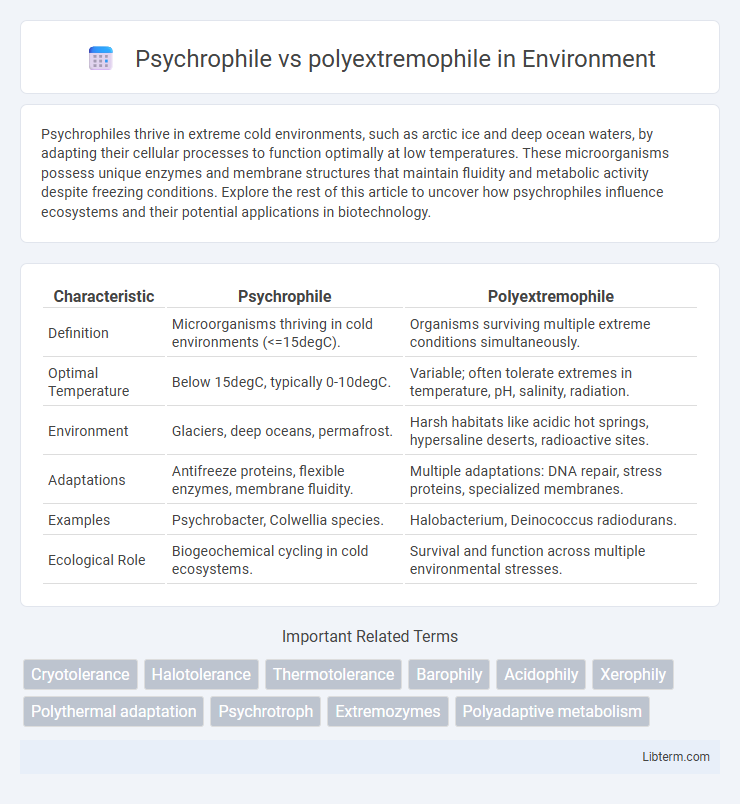Psychrophiles thrive in extreme cold environments, such as arctic ice and deep ocean waters, by adapting their cellular processes to function optimally at low temperatures. These microorganisms possess unique enzymes and membrane structures that maintain fluidity and metabolic activity despite freezing conditions. Explore the rest of this article to uncover how psychrophiles influence ecosystems and their potential applications in biotechnology.
Table of Comparison
| Characteristic | Psychrophile | Polyextremophile |
|---|---|---|
| Definition | Microorganisms thriving in cold environments (<=15degC). | Organisms surviving multiple extreme conditions simultaneously. |
| Optimal Temperature | Below 15degC, typically 0-10degC. | Variable; often tolerate extremes in temperature, pH, salinity, radiation. |
| Environment | Glaciers, deep oceans, permafrost. | Harsh habitats like acidic hot springs, hypersaline deserts, radioactive sites. |
| Adaptations | Antifreeze proteins, flexible enzymes, membrane fluidity. | Multiple adaptations: DNA repair, stress proteins, specialized membranes. |
| Examples | Psychrobacter, Colwellia species. | Halobacterium, Deinococcus radiodurans. |
| Ecological Role | Biogeochemical cycling in cold ecosystems. | Survival and function across multiple environmental stresses. |
Introduction to Extremophiles
Extremophiles are organisms adapted to survive in harsh environmental conditions, with psychrophiles thriving specifically in consistently cold temperatures below 15degC, often found in polar regions and deep ocean habitats. Polyextremophiles endure multiple extreme conditions simultaneously, such as intense cold, high salinity, and pressure, making them invaluable for studying biochemical adaptations and potential astrobiological applications. Understanding psychrophilic and polyextremophilic mechanisms offers insights into molecular stability and enzymatic functions under stress, expanding biotechnological and ecological research frontiers.
Defining Psychrophiles
Psychrophiles are microorganisms that thrive in consistently cold environments, typically at temperatures below 15degC, with optimal growth around 0-10degC; they possess specialized enzymes and membrane structures adapted to maintain cellular function in extreme cold. Unlike polyextremophiles, which survive multiple extreme conditions such as high salinity, acidity, or pressure along with temperature extremes, psychrophiles are specifically adapted to cold climate habitats like polar regions, deep ocean waters, and alpine ecosystems. Their unique cold-adaptation mechanisms include antifreeze proteins and increased membrane fluidity essential for metabolic processes in subzero environments.
Understanding Polyextremophiles
Polyextremophiles are organisms capable of thriving in multiple extreme environmental conditions, such as extreme cold, high salinity, and high radiation, distinguishing them from psychrophiles that specifically adapt to cold environments. These organisms possess specialized biochemical and genetic adaptations that enable cellular stability and metabolic function under combined stresses, making them a key focus in astrobiology and biotechnology. Understanding polyextremophiles expands insights into life's resilience and potential for survival in extraterrestrial habitats.
Key Environmental Adaptations
Psychrophiles thrive in permanently cold environments, exhibiting adaptations such as flexible cell membranes rich in unsaturated fatty acids and cold-active enzymes to maintain metabolic efficiency at low temperatures. Polyextremophiles possess versatile adaptations allowing survival under multiple extreme conditions, including heat, acidity, salinity, and radiation, often by synthesizing protective solutes, stabilizing proteins, and efficient DNA repair mechanisms. These adaptive strategies enable psychrophiles and polyextremophiles to colonize habitats ranging from polar ice caps to acidic hot springs and hypersaline lakes, underscoring their ecological and biotechnological significance.
Comparative Survival Mechanisms
Psychrophiles thrive in permanently cold environments by producing antifreeze proteins and maintaining membrane fluidity through high unsaturated fatty acid content. Polyextremophiles possess adaptive mechanisms such as specialized DNA repair systems and compatible solute accumulation, allowing survival under multiple stressors including extreme temperature, pH, and salinity. Comparative analysis reveals psychrophiles specialize in cold adaptation, whereas polyextremophiles employ a broader, multi-stress tolerance strategy incorporating overlapping protective pathways.
Genetic and Metabolic Features
Psychrophiles possess unique genetic adaptations such as cold-active enzymes and flexible membrane lipid compositions that enable efficient metabolic processes at low temperatures. Polyextremophiles exhibit versatile genetic traits promoting resilience, including stress response genes and metabolic pathways that support survival under multiple extreme conditions like high salinity, acidity, or radiation. Metabolically, psychrophiles rely on antifreeze proteins and cryoprotectants, whereas polyextremophiles produce a diverse array of protective metabolites that stabilize cellular components across varied harsh environments.
Ecological Niches and Distribution
Psychrophiles thrive primarily in consistently cold environments such as polar ice caps, deep ocean waters, and alpine regions, where temperatures remain below 15degC. Polyextremophiles inhabit multiple extreme conditions simultaneously, including combinations of cold, high salinity, acidity, or radiation, often found in unique habitats like acidic glaciers, hypersaline lakes, or deep-sea hydrothermal vents. The ecological niches of psychrophiles are narrowly defined by low temperature, while polyextremophiles occupy more diverse and challenging habitats with overlapping stress factors, resulting in broader but specialized global distributions.
Biotechnological Applications
Psychrophiles, thriving at temperatures below 15degC, produce cold-active enzymes that are invaluable in biotechnological applications such as bioremediation in cold environments and the development of bio-detergents. Polyextremophiles, capable of surviving multiple extreme conditions (e.g., temperature, salinity, pH), offer robust enzymes ideal for industrial processes requiring stability under harsh conditions, including pharmaceuticals, biofuels, and food processing. The unique adaptations of both groups enable the exploitation of their biomolecules for innovative biotechnological solutions in environmental sustainability and industrial efficiency.
Challenges in Research and Cultivation
Psychrophiles, organisms thriving in extremely cold environments, pose challenges in research and cultivation due to the necessity of maintaining subzero temperatures and mimicking natural cold habitats in the laboratory. Polyextremophiles, capable of surviving multiple extreme conditions such as high salinity, acidity, and temperature fluctuations, require complex, multifactorial cultivation setups that replicate overlapping stress factors for accurate study. Both types demand specialized equipment and protocols to sustain their physiological states, complicating isolation, growth, and biochemical analysis.
Future Directions in Extremophile Studies
Future directions in extremophile studies emphasize integrating multi-omics approaches to unravel the adaptive mechanisms of psychrophiles and polyextremophiles in extreme environments, such as Arctic permafrost and deep-sea hydrothermal vents. Advances in metagenomics and proteomics enable the discovery of novel enzymes with industrial and biotechnological applications, particularly those functioning efficiently at low temperatures or under multifactorial stress conditions. Expanding research on the genetic and metabolic networks governing polyextremophiles will enhance synthetic biology strategies, fostering the development of robust bioengineering systems for climate resilience and astrobiology exploration.
Psychrophile Infographic

 libterm.com
libterm.com